Kotter and Schlesinger change management model
VerifiedAdded on 2022/08/12
|7
|1611
|37
AI Summary
Contribute Materials
Your contribution can guide someone’s learning journey. Share your
documents today.
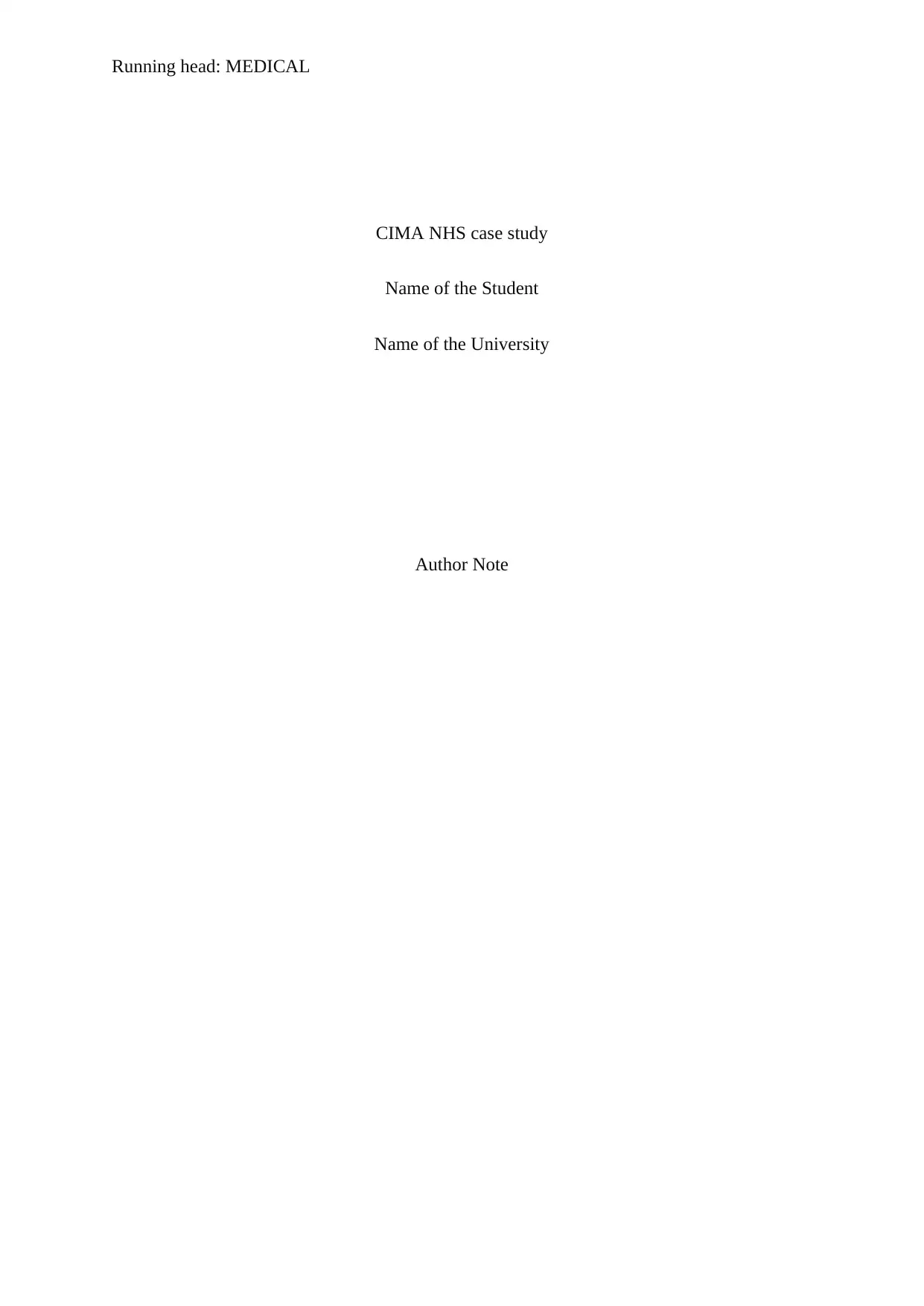
Running head: MEDICAL
CIMA NHS case study
Name of the Student
Name of the University
Author Note
CIMA NHS case study
Name of the Student
Name of the University
Author Note
Secure Best Marks with AI Grader
Need help grading? Try our AI Grader for instant feedback on your assignments.
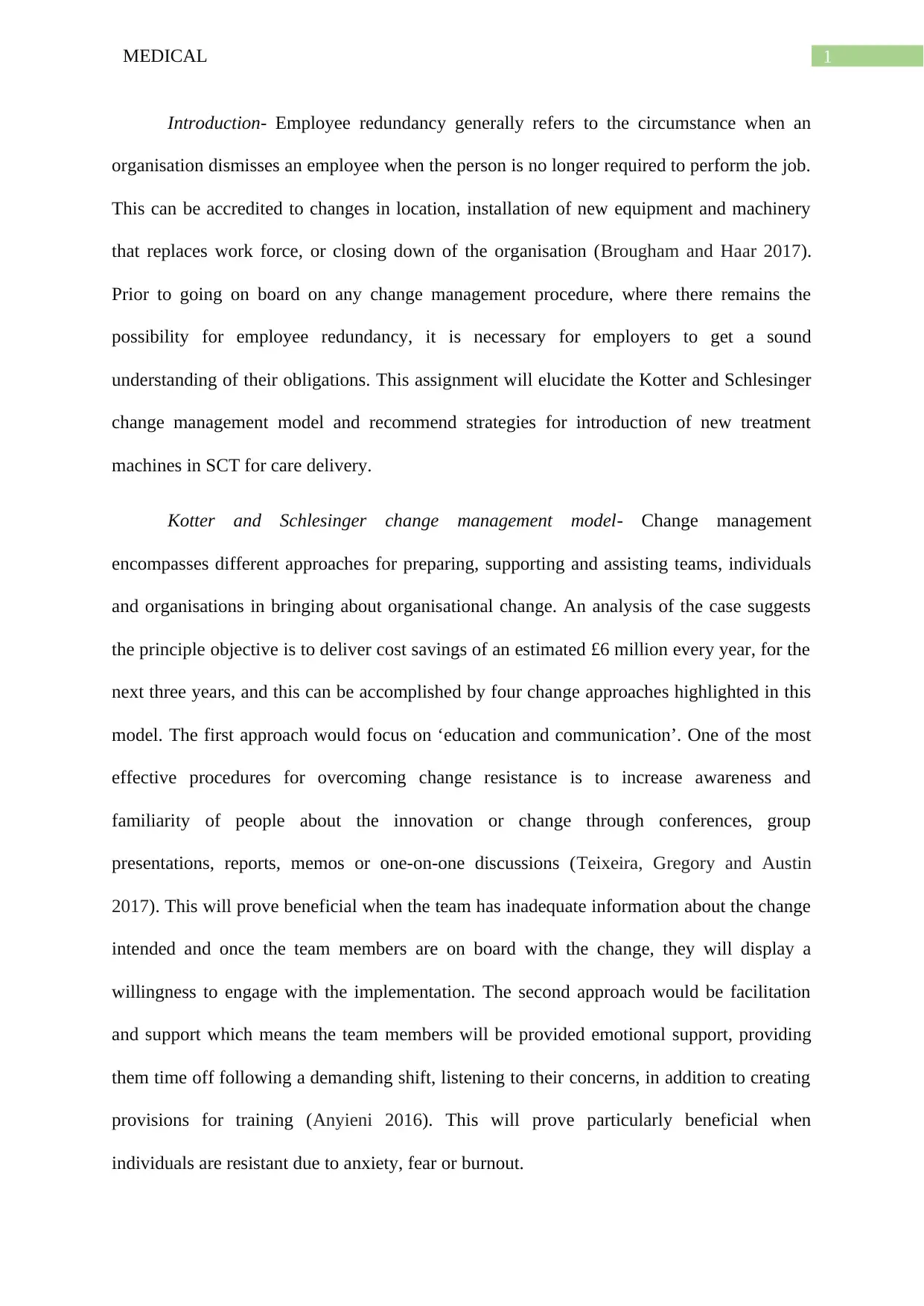
1MEDICAL
Introduction- Employee redundancy generally refers to the circumstance when an
organisation dismisses an employee when the person is no longer required to perform the job.
This can be accredited to changes in location, installation of new equipment and machinery
that replaces work force, or closing down of the organisation (Brougham and Haar 2017).
Prior to going on board on any change management procedure, where there remains the
possibility for employee redundancy, it is necessary for employers to get a sound
understanding of their obligations. This assignment will elucidate the Kotter and Schlesinger
change management model and recommend strategies for introduction of new treatment
machines in SCT for care delivery.
Kotter and Schlesinger change management model- Change management
encompasses different approaches for preparing, supporting and assisting teams, individuals
and organisations in bringing about organisational change. An analysis of the case suggests
the principle objective is to deliver cost savings of an estimated £6 million every year, for the
next three years, and this can be accomplished by four change approaches highlighted in this
model. The first approach would focus on ‘education and communication’. One of the most
effective procedures for overcoming change resistance is to increase awareness and
familiarity of people about the innovation or change through conferences, group
presentations, reports, memos or one-on-one discussions (Teixeira, Gregory and Austin
2017). This will prove beneficial when the team has inadequate information about the change
intended and once the team members are on board with the change, they will display a
willingness to engage with the implementation. The second approach would be facilitation
and support which means the team members will be provided emotional support, providing
them time off following a demanding shift, listening to their concerns, in addition to creating
provisions for training (Anyieni 2016). This will prove particularly beneficial when
individuals are resistant due to anxiety, fear or burnout.
Introduction- Employee redundancy generally refers to the circumstance when an
organisation dismisses an employee when the person is no longer required to perform the job.
This can be accredited to changes in location, installation of new equipment and machinery
that replaces work force, or closing down of the organisation (Brougham and Haar 2017).
Prior to going on board on any change management procedure, where there remains the
possibility for employee redundancy, it is necessary for employers to get a sound
understanding of their obligations. This assignment will elucidate the Kotter and Schlesinger
change management model and recommend strategies for introduction of new treatment
machines in SCT for care delivery.
Kotter and Schlesinger change management model- Change management
encompasses different approaches for preparing, supporting and assisting teams, individuals
and organisations in bringing about organisational change. An analysis of the case suggests
the principle objective is to deliver cost savings of an estimated £6 million every year, for the
next three years, and this can be accomplished by four change approaches highlighted in this
model. The first approach would focus on ‘education and communication’. One of the most
effective procedures for overcoming change resistance is to increase awareness and
familiarity of people about the innovation or change through conferences, group
presentations, reports, memos or one-on-one discussions (Teixeira, Gregory and Austin
2017). This will prove beneficial when the team has inadequate information about the change
intended and once the team members are on board with the change, they will display a
willingness to engage with the implementation. The second approach would be facilitation
and support which means the team members will be provided emotional support, providing
them time off following a demanding shift, listening to their concerns, in addition to creating
provisions for training (Anyieni 2016). This will prove particularly beneficial when
individuals are resistant due to anxiety, fear or burnout.
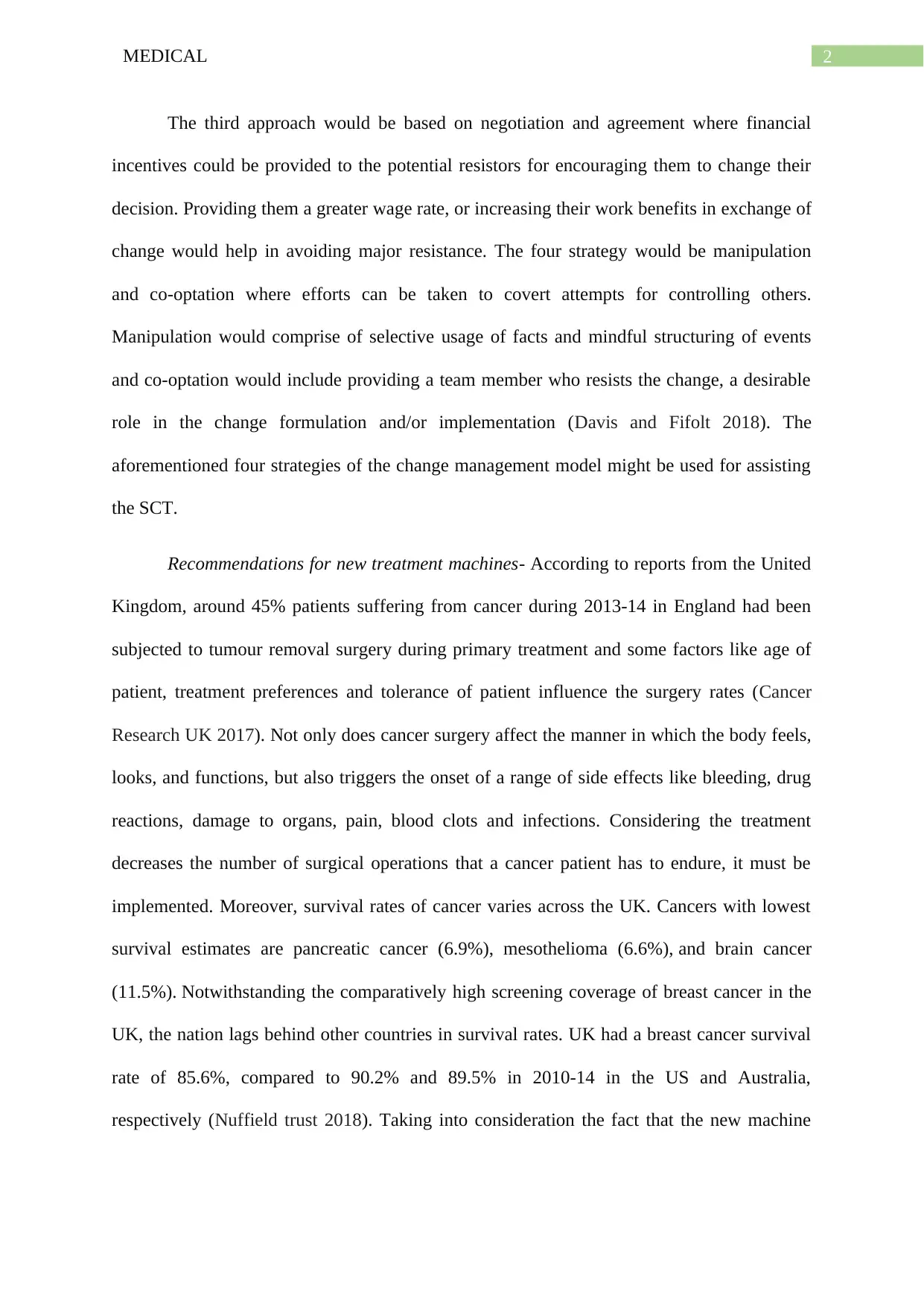
2MEDICAL
The third approach would be based on negotiation and agreement where financial
incentives could be provided to the potential resistors for encouraging them to change their
decision. Providing them a greater wage rate, or increasing their work benefits in exchange of
change would help in avoiding major resistance. The four strategy would be manipulation
and co-optation where efforts can be taken to covert attempts for controlling others.
Manipulation would comprise of selective usage of facts and mindful structuring of events
and co-optation would include providing a team member who resists the change, a desirable
role in the change formulation and/or implementation (Davis and Fifolt 2018). The
aforementioned four strategies of the change management model might be used for assisting
the SCT.
Recommendations for new treatment machines- According to reports from the United
Kingdom, around 45% patients suffering from cancer during 2013-14 in England had been
subjected to tumour removal surgery during primary treatment and some factors like age of
patient, treatment preferences and tolerance of patient influence the surgery rates (Cancer
Research UK 2017). Not only does cancer surgery affect the manner in which the body feels,
looks, and functions, but also triggers the onset of a range of side effects like bleeding, drug
reactions, damage to organs, pain, blood clots and infections. Considering the treatment
decreases the number of surgical operations that a cancer patient has to endure, it must be
implemented. Moreover, survival rates of cancer varies across the UK. Cancers with lowest
survival estimates are pancreatic cancer (6.9%), mesothelioma (6.6%), and brain cancer
(11.5%). Notwithstanding the comparatively high screening coverage of breast cancer in the
UK, the nation lags behind other countries in survival rates. UK had a breast cancer survival
rate of 85.6%, compared to 90.2% and 89.5% in 2010-14 in the US and Australia,
respectively (Nuffield trust 2018). Taking into consideration the fact that the new machine
The third approach would be based on negotiation and agreement where financial
incentives could be provided to the potential resistors for encouraging them to change their
decision. Providing them a greater wage rate, or increasing their work benefits in exchange of
change would help in avoiding major resistance. The four strategy would be manipulation
and co-optation where efforts can be taken to covert attempts for controlling others.
Manipulation would comprise of selective usage of facts and mindful structuring of events
and co-optation would include providing a team member who resists the change, a desirable
role in the change formulation and/or implementation (Davis and Fifolt 2018). The
aforementioned four strategies of the change management model might be used for assisting
the SCT.
Recommendations for new treatment machines- According to reports from the United
Kingdom, around 45% patients suffering from cancer during 2013-14 in England had been
subjected to tumour removal surgery during primary treatment and some factors like age of
patient, treatment preferences and tolerance of patient influence the surgery rates (Cancer
Research UK 2017). Not only does cancer surgery affect the manner in which the body feels,
looks, and functions, but also triggers the onset of a range of side effects like bleeding, drug
reactions, damage to organs, pain, blood clots and infections. Considering the treatment
decreases the number of surgical operations that a cancer patient has to endure, it must be
implemented. Moreover, survival rates of cancer varies across the UK. Cancers with lowest
survival estimates are pancreatic cancer (6.9%), mesothelioma (6.6%), and brain cancer
(11.5%). Notwithstanding the comparatively high screening coverage of breast cancer in the
UK, the nation lags behind other countries in survival rates. UK had a breast cancer survival
rate of 85.6%, compared to 90.2% and 89.5% in 2010-14 in the US and Australia,
respectively (Nuffield trust 2018). Taking into consideration the fact that the new machine
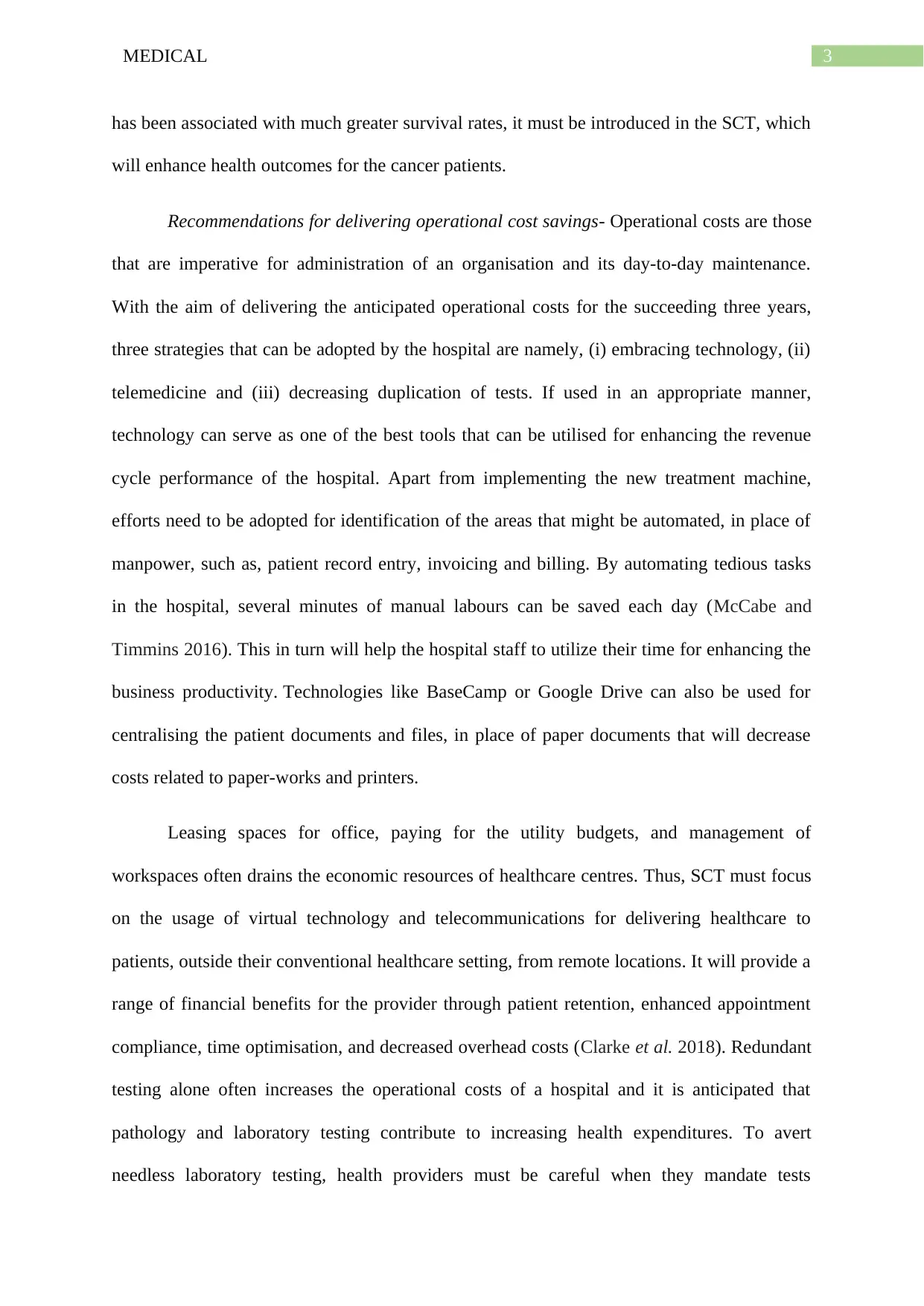
3MEDICAL
has been associated with much greater survival rates, it must be introduced in the SCT, which
will enhance health outcomes for the cancer patients.
Recommendations for delivering operational cost savings- Operational costs are those
that are imperative for administration of an organisation and its day-to-day maintenance.
With the aim of delivering the anticipated operational costs for the succeeding three years,
three strategies that can be adopted by the hospital are namely, (i) embracing technology, (ii)
telemedicine and (iii) decreasing duplication of tests. If used in an appropriate manner,
technology can serve as one of the best tools that can be utilised for enhancing the revenue
cycle performance of the hospital. Apart from implementing the new treatment machine,
efforts need to be adopted for identification of the areas that might be automated, in place of
manpower, such as, patient record entry, invoicing and billing. By automating tedious tasks
in the hospital, several minutes of manual labours can be saved each day (McCabe and
Timmins 2016). This in turn will help the hospital staff to utilize their time for enhancing the
business productivity. Technologies like BaseCamp or Google Drive can also be used for
centralising the patient documents and files, in place of paper documents that will decrease
costs related to paper-works and printers.
Leasing spaces for office, paying for the utility budgets, and management of
workspaces often drains the economic resources of healthcare centres. Thus, SCT must focus
on the usage of virtual technology and telecommunications for delivering healthcare to
patients, outside their conventional healthcare setting, from remote locations. It will provide a
range of financial benefits for the provider through patient retention, enhanced appointment
compliance, time optimisation, and decreased overhead costs (Clarke et al. 2018). Redundant
testing alone often increases the operational costs of a hospital and it is anticipated that
pathology and laboratory testing contribute to increasing health expenditures. To avert
needless laboratory testing, health providers must be careful when they mandate tests
has been associated with much greater survival rates, it must be introduced in the SCT, which
will enhance health outcomes for the cancer patients.
Recommendations for delivering operational cost savings- Operational costs are those
that are imperative for administration of an organisation and its day-to-day maintenance.
With the aim of delivering the anticipated operational costs for the succeeding three years,
three strategies that can be adopted by the hospital are namely, (i) embracing technology, (ii)
telemedicine and (iii) decreasing duplication of tests. If used in an appropriate manner,
technology can serve as one of the best tools that can be utilised for enhancing the revenue
cycle performance of the hospital. Apart from implementing the new treatment machine,
efforts need to be adopted for identification of the areas that might be automated, in place of
manpower, such as, patient record entry, invoicing and billing. By automating tedious tasks
in the hospital, several minutes of manual labours can be saved each day (McCabe and
Timmins 2016). This in turn will help the hospital staff to utilize their time for enhancing the
business productivity. Technologies like BaseCamp or Google Drive can also be used for
centralising the patient documents and files, in place of paper documents that will decrease
costs related to paper-works and printers.
Leasing spaces for office, paying for the utility budgets, and management of
workspaces often drains the economic resources of healthcare centres. Thus, SCT must focus
on the usage of virtual technology and telecommunications for delivering healthcare to
patients, outside their conventional healthcare setting, from remote locations. It will provide a
range of financial benefits for the provider through patient retention, enhanced appointment
compliance, time optimisation, and decreased overhead costs (Clarke et al. 2018). Redundant
testing alone often increases the operational costs of a hospital and it is anticipated that
pathology and laboratory testing contribute to increasing health expenditures. To avert
needless laboratory testing, health providers must be careful when they mandate tests
Secure Best Marks with AI Grader
Need help grading? Try our AI Grader for instant feedback on your assignments.
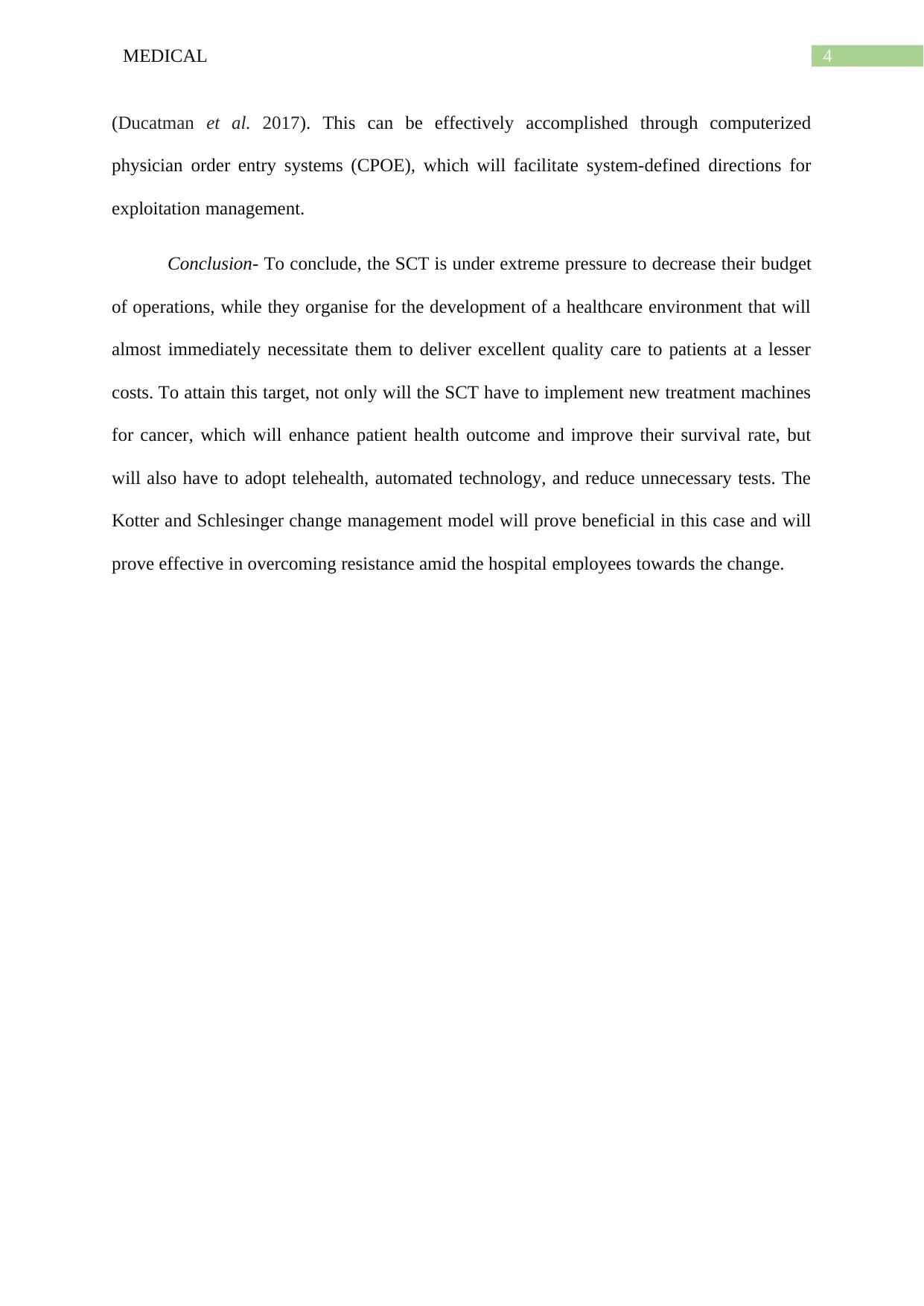
4MEDICAL
(Ducatman et al. 2017). This can be effectively accomplished through computerized
physician order entry systems (CPOE), which will facilitate system-defined directions for
exploitation management.
Conclusion- To conclude, the SCT is under extreme pressure to decrease their budget
of operations, while they organise for the development of a healthcare environment that will
almost immediately necessitate them to deliver excellent quality care to patients at a lesser
costs. To attain this target, not only will the SCT have to implement new treatment machines
for cancer, which will enhance patient health outcome and improve their survival rate, but
will also have to adopt telehealth, automated technology, and reduce unnecessary tests. The
Kotter and Schlesinger change management model will prove beneficial in this case and will
prove effective in overcoming resistance amid the hospital employees towards the change.
(Ducatman et al. 2017). This can be effectively accomplished through computerized
physician order entry systems (CPOE), which will facilitate system-defined directions for
exploitation management.
Conclusion- To conclude, the SCT is under extreme pressure to decrease their budget
of operations, while they organise for the development of a healthcare environment that will
almost immediately necessitate them to deliver excellent quality care to patients at a lesser
costs. To attain this target, not only will the SCT have to implement new treatment machines
for cancer, which will enhance patient health outcome and improve their survival rate, but
will also have to adopt telehealth, automated technology, and reduce unnecessary tests. The
Kotter and Schlesinger change management model will prove beneficial in this case and will
prove effective in overcoming resistance amid the hospital employees towards the change.
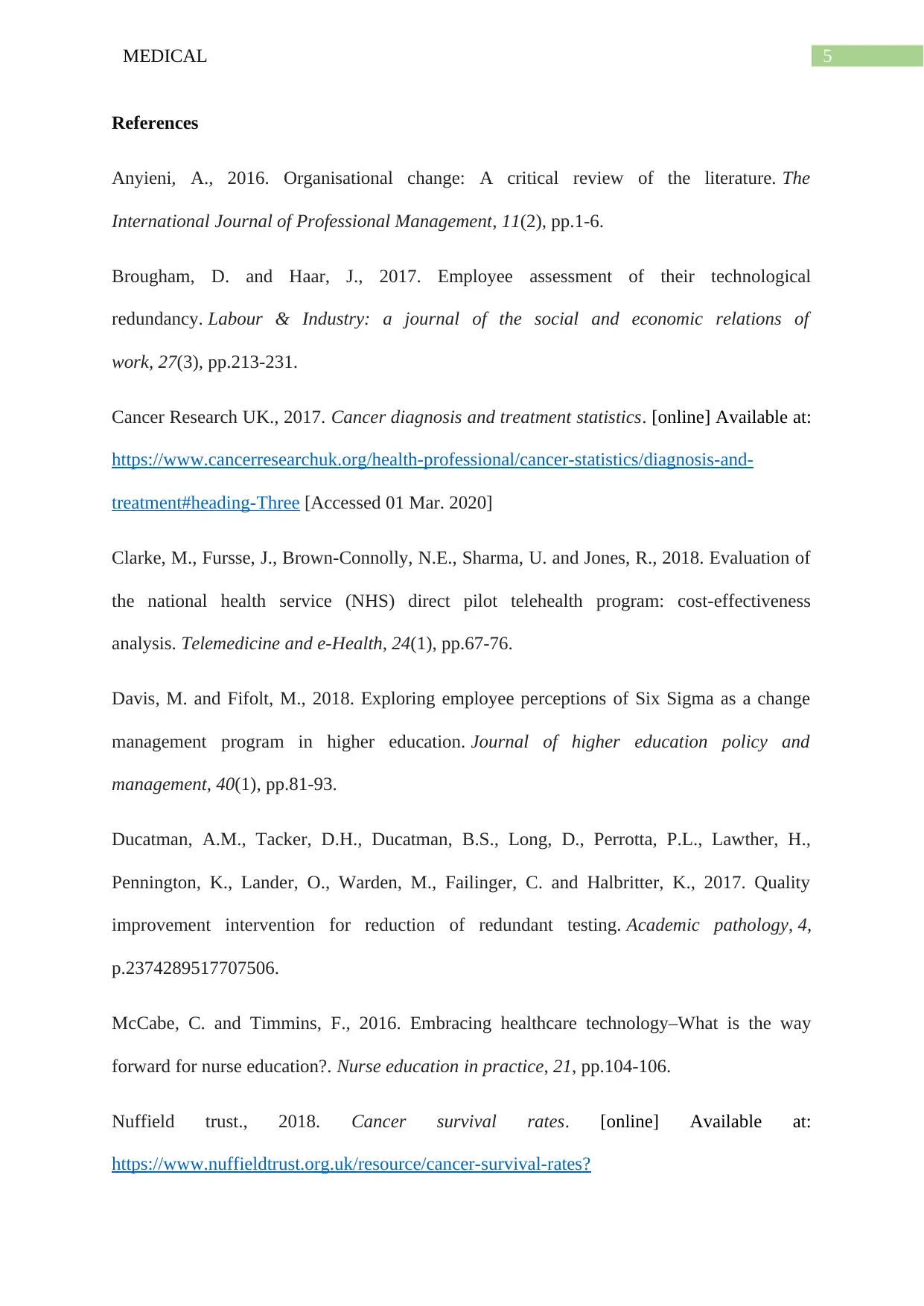
5MEDICAL
References
Anyieni, A., 2016. Organisational change: A critical review of the literature. The
International Journal of Professional Management, 11(2), pp.1-6.
Brougham, D. and Haar, J., 2017. Employee assessment of their technological
redundancy. Labour & Industry: a journal of the social and economic relations of
work, 27(3), pp.213-231.
Cancer Research UK., 2017. Cancer diagnosis and treatment statistics. [online] Available at:
https://www.cancerresearchuk.org/health-professional/cancer-statistics/diagnosis-and-
treatment#heading-Three [Accessed 01 Mar. 2020]
Clarke, M., Fursse, J., Brown-Connolly, N.E., Sharma, U. and Jones, R., 2018. Evaluation of
the national health service (NHS) direct pilot telehealth program: cost-effectiveness
analysis. Telemedicine and e-Health, 24(1), pp.67-76.
Davis, M. and Fifolt, M., 2018. Exploring employee perceptions of Six Sigma as a change
management program in higher education. Journal of higher education policy and
management, 40(1), pp.81-93.
Ducatman, A.M., Tacker, D.H., Ducatman, B.S., Long, D., Perrotta, P.L., Lawther, H.,
Pennington, K., Lander, O., Warden, M., Failinger, C. and Halbritter, K., 2017. Quality
improvement intervention for reduction of redundant testing. Academic pathology, 4,
p.2374289517707506.
McCabe, C. and Timmins, F., 2016. Embracing healthcare technology–What is the way
forward for nurse education?. Nurse education in practice, 21, pp.104-106.
Nuffield trust., 2018. Cancer survival rates. [online] Available at:
https://www.nuffieldtrust.org.uk/resource/cancer-survival-rates?
References
Anyieni, A., 2016. Organisational change: A critical review of the literature. The
International Journal of Professional Management, 11(2), pp.1-6.
Brougham, D. and Haar, J., 2017. Employee assessment of their technological
redundancy. Labour & Industry: a journal of the social and economic relations of
work, 27(3), pp.213-231.
Cancer Research UK., 2017. Cancer diagnosis and treatment statistics. [online] Available at:
https://www.cancerresearchuk.org/health-professional/cancer-statistics/diagnosis-and-
treatment#heading-Three [Accessed 01 Mar. 2020]
Clarke, M., Fursse, J., Brown-Connolly, N.E., Sharma, U. and Jones, R., 2018. Evaluation of
the national health service (NHS) direct pilot telehealth program: cost-effectiveness
analysis. Telemedicine and e-Health, 24(1), pp.67-76.
Davis, M. and Fifolt, M., 2018. Exploring employee perceptions of Six Sigma as a change
management program in higher education. Journal of higher education policy and
management, 40(1), pp.81-93.
Ducatman, A.M., Tacker, D.H., Ducatman, B.S., Long, D., Perrotta, P.L., Lawther, H.,
Pennington, K., Lander, O., Warden, M., Failinger, C. and Halbritter, K., 2017. Quality
improvement intervention for reduction of redundant testing. Academic pathology, 4,
p.2374289517707506.
McCabe, C. and Timmins, F., 2016. Embracing healthcare technology–What is the way
forward for nurse education?. Nurse education in practice, 21, pp.104-106.
Nuffield trust., 2018. Cancer survival rates. [online] Available at:
https://www.nuffieldtrust.org.uk/resource/cancer-survival-rates?
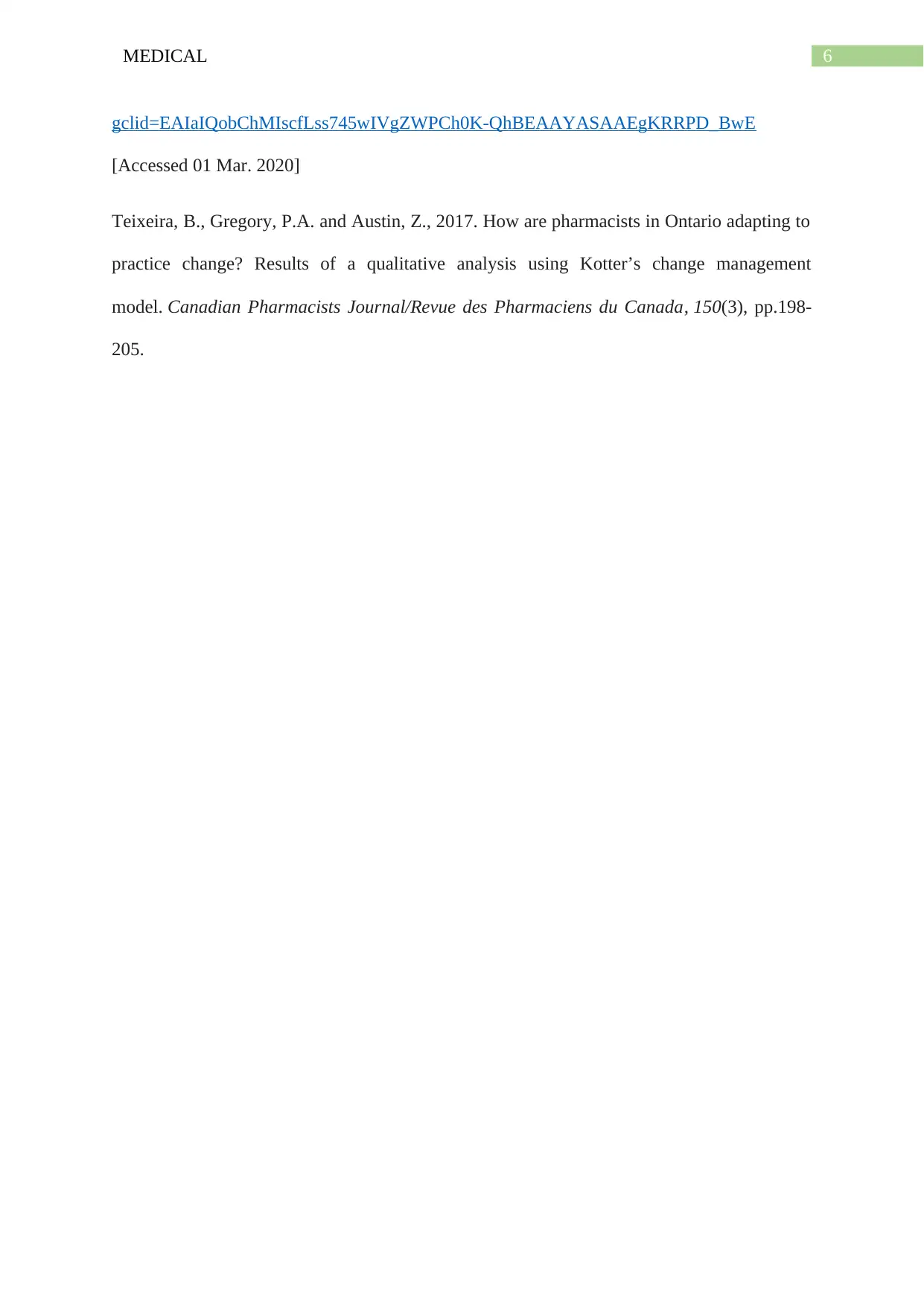
6MEDICAL
gclid=EAIaIQobChMIscfLss745wIVgZWPCh0K-QhBEAAYASAAEgKRRPD_BwE
[Accessed 01 Mar. 2020]
Teixeira, B., Gregory, P.A. and Austin, Z., 2017. How are pharmacists in Ontario adapting to
practice change? Results of a qualitative analysis using Kotter’s change management
model. Canadian Pharmacists Journal/Revue des Pharmaciens du Canada, 150(3), pp.198-
205.
gclid=EAIaIQobChMIscfLss745wIVgZWPCh0K-QhBEAAYASAAEgKRRPD_BwE
[Accessed 01 Mar. 2020]
Teixeira, B., Gregory, P.A. and Austin, Z., 2017. How are pharmacists in Ontario adapting to
practice change? Results of a qualitative analysis using Kotter’s change management
model. Canadian Pharmacists Journal/Revue des Pharmaciens du Canada, 150(3), pp.198-
205.
1 out of 7
Related Documents
Your All-in-One AI-Powered Toolkit for Academic Success.
+13062052269
info@desklib.com
Available 24*7 on WhatsApp / Email
![[object Object]](/_next/static/media/star-bottom.7253800d.svg)
Unlock your academic potential
© 2024 | Zucol Services PVT LTD | All rights reserved.
